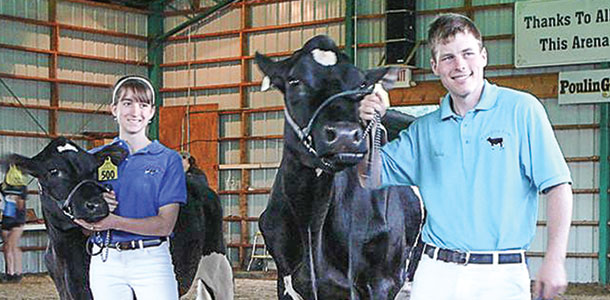Andy Birch and his wife, Sarah, own Maple Grove Farm in Derby, Vermont. They milk 50 registered Holsteins, Jerseys and Brown Swiss, and farm 45 acres of corn and 70 acres of pasture.
The Birches were recently featured in a USA Today article and video, about the growing numbers of farmers in their 20s and 30s, titled “Get ‘into the dirt’: More young people start farms.” Progressive Dairyman asked Andy to answer a few questions about how the article came about.
How did your interview with USA Today come about?
The New England Dairy Promotion Board pitched the story to USA Today, citing USDA statistics that the dairy farming community is rapidly approaching the point of retirement.
They wanted to run a story on millennial farmers entering the business, bringing new blood and enthusiasm. They recommended my farm as a possible focus since I had recently started farming and went through the Young Dairy Leaders’ Institute (YDLI) in 2012.
Why did you consent to the interview?
I wanted to demonstrate that it is possible for young people to get started in the dairy industry. I have always hated the notion that dairy is a “sunset industry” in Vermont when it is actually growing. There is a good future in the dairy industry for those who have the determination to make it happen.
It was a good opportunity to connect with the thousands of people who read the newspaper and tell our story. If the article helps sell some of our Cabot cheese, that is great. If it brings some new understanding to dairy or even some new people, that is even better.
Were you nervous before it? What did you do to prepare?
I was a little nervous, and so was my wife, Sarah. Dairy Management Inc. helped prepare us for the interview with practice questions we would likely be asked. My YDLI training helped too.
Have you done other interviews before?
I have done interviews in the past with local newspapers, mostly when I was a 4-H member. I also did an interview with my local CBS station during college, discussing the issues surrounding raw milk sales in Vermont.
What was most odd or surprising to you about the reporter’s visit or questions?
I was surprised by how many of the questions dealt with money and finance. I did not feel very prepared for that line of questioning. Most of the preparation had focused on why I like farming and how people can get into the dairy industry from the outside. I should have done more research on the reporter, who writes mostly in the money section of USA Today.
Most of the financial questions did not make it into the final article though, so it did not have a big impact on the finished product.

What was the most difficult question you had to answer?
“How much money are you going to make annually?” First, that is a very personal question and one that is nearly impossible for a dairy farmer to forecast, especially a startup. The writer said that I could make as much as $60,000 annually. In the interview, I was clear that there were no guarantees and I could have a loss, a low profit or a high profit in a perfect year.
How long did the videotaping take? Did it get in the way of your normal operations?
The videotaping took about half an hour – twice. The sound file was corrupted in the original video, so the videographer had to come back a few days later.
We timed it just before the start of chores, so the taping did not interfere with our schedule. She stayed through the beginning of chores – which was only a problem while we were bringing cows into the barn. They didn’t like the lights and sounds coming from the camera.
Were you satisfied with the video and article they produced?
Overall, I was happy with the video and article. I was able to wear my Cabot shirt and promote my cooperative. The one photo I didn’t like was one where I was preparing a dose of dexamethasone with the Cabot logo on my shirt in the background.
Although I explained what I was doing and why when the photographer was there, the photo caption did not include the information. I wonder if it could be misinterpreted by a consumer.
Have you made any new connections or had any interesting experiences as a result of the story airing?
A week after the article ran, my wife, Sarah, received an e-mail asking if we could be featured in a dairy blog written by Mary Mackinson of Mackinson Dairy in Illinois. She said that our video inspired her to write a “30 Days of Dairy” series, featuring a different young farmer every day in November.
Also, we received a message from a person who grew up on our farm in the 1950s saying how surprised she was to see her old home in a national newspaper. She hopes to visit the farm next summer now that we are milking again.
Overall, was it worthwhile to do the interview?
Based on the positive response, it was well worth the time to do the interview. We were given the opportunity to tell our story to a national audience and, hopefully, give some voice to all of the other young farmers who are in the same shoes.
What advice would you have for other dairy producers who may be doing interviews?
It is important to take every opportunity to cast the dairy industry in a positive light. Dairy farmers are the best people to tell their own stories and need to make an effort to be heard. Consumers need to see us as the real people we are. All of the dairy checkoff marketing in the world cannot do that as effectively as farmers speaking for themselves. PD
PHOTO
From left to right: Daughter Maplegrove-B Cole Spritz P, Sarah Birch, dam Maplegrove-B Mitey Splash P and Andy Birch. The Birches were showing the polled dam and daughter at a dam and produce class at the Orleans County Fair in Vermont. Photo courtesy of Julie Brochu.




